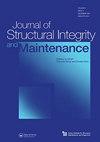底灰骨料与泡沫空气轻量混凝土的剪切摩擦响应
IF 3.1
Q2 ENGINEERING, CIVIL
Journal of Structural Integrity and Maintenance
Pub Date : 2021-01-02
DOI:10.1080/24705314.2020.1823557
引用次数: 2
摘要
摘要本研究旨在评估底灰骨料-泡沫空气轻质混凝土(LWC-BF)在不同界面条件下的抗剪摩擦响应,确定该混凝土的抗剪传递能力、粘聚力和摩擦角等设计参数。根据混凝土塑性上界定理推导出的综合力学模型的扩展版本,直接推导出剪切摩擦参数。对18个非加筋推脱试件(9个整体界面和9个光滑施工缝界面)进行了直剪和通常施加在界面上的附加压应力试验。不同界面条件下考虑的试验参数为混凝土抗压强度和压应力大小。实验和分析结果表明,泡沫空气的加入使整体界面的摩擦角略有降低,但对光滑施工缝的摩擦角影响不显著。因此,体积掺量达到20%的泡沫空气对混凝土黏聚力和摩擦角的影响是微乎其微的。因此,所提出的剪切摩擦参数有望合理地评价LWC-BF界面的剪切摩擦强度。本文章由计算机程序翻译,如有差异,请以英文原文为准。
Shear friction response of lightweight concrete using bottom ash aggregates and air foams
ABSTRACT This study aimed to estimate the shear friction response of lightweight concrete made using bottom ash aggregates and air foam (LWC-BF) and determine the design parameters including shear transfer capacity, cohesion, and friction angle of such concrete at different interface conditions. The shear friction parameters were straightforwardly formulated from the extension version of the integrated mechanical models derived in our previous study based on the upper bound theorem of concrete plasticity. Eighteen non-reinforced push-off specimens (nine monolithic interfaces and nine interfaces with smooth construction joints) were tested under direct shear and the additional compressive stresses normally applied to the interfaces. The test parameters considered in different interface conditions were the compressive strength of concrete and the magnitude of compressive stresses. The experimental and analytical results showed that the addition of air foam slightly decreases the angle of friction of monolithic interfaces but insignificantly affects that of smooth construction joints. Thus, the effect of air foam added up to 20% by volume on the cohesion and friction angle of concrete was marginal. Therefore, the proposed shear friction parameters are promising to reasonably assess the shear friction strength of LWC-BF interfaces.
求助全文
通过发布文献求助,成功后即可免费获取论文全文。
去求助
来源期刊

Journal of Structural Integrity and Maintenance
ENGINEERING, CIVIL-
CiteScore
3.90
自引率
9.50%
发文量
24
 求助内容:
求助内容: 应助结果提醒方式:
应助结果提醒方式:


